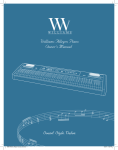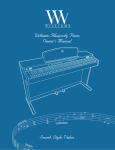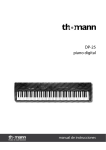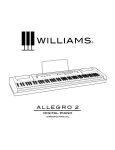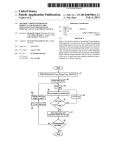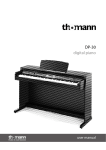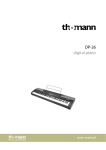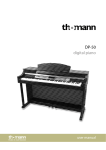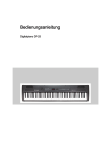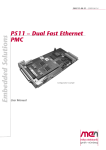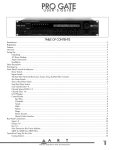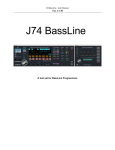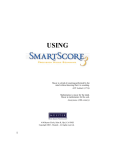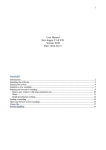Download DP-25 digital piano
Transcript
DP-25 digital piano user manual Musikhaus Thomann e.K. Treppendorf 30 96138 Burgebrach Germany Telephone: +49 (0) 9546 9223-0 email: [email protected] Internet: www.thomann.de 13.02.2012 Table of contents Table of contents 1 General notes............................................................................................................................ 4 2 Safety instructions................................................................................................................. 5 3 Introduction.............................................................................................................................. 7 4 Operating panel and connections.................................................................................. 8 5 Setup and switch on............................................................................................................ 10 6 Connections............................................................................................................................ 11 7 Operating elements............................................................................................................ 12 8 Demo songs............................................................................................................................. 13 9 Voices ........................................................................................................................................ 16 10 Split mode................................................................................................................................ 17 11 Layer mode.............................................................................................................................. 19 12 Metronome.............................................................................................................................. 21 13 Transpose................................................................................................................................. 22 14 Octave shift ............................................................................................................................ 23 15 Song recording...................................................................................................................... 24 16 Edit functions......................................................................................................................... 28 17 MIDI functions........................................................................................................................ 30 18 Appendix.................................................................................................................................. 39 19 Technical specifications.................................................................................................... 49 20 Protecting the environment........................................................................................... 50 DP-25 3 General notes 1 General notes This user manual contains important information on the safe operation of the device. Read and follow all safety notes and all instructions. Save this manual for future refer‐ ence. Make sure that it is available to all persons using this device. If you sell the device to another user, be sure that they also receive this manual. Our products are subject to a process of continuous development. We therefore reserve the right to make changes without notice. Symbols and signal words This section gives an overview of the symbols and signal words used in this user manual. Signal word Meaning DANGER! This combination of symbol and signal word indicates an immediate dangerous situation that will result in death or serious injury if it is not avoided. CAUTION! This combination of symbol and signal word indicates a possible dangerous sit‐ uation that can result in minor injury if it is not avoided. NOTICE! This combination of symbol and signal word indicates a possible dangerous sit‐ uation that can result in material and environmental damage if it is not avoided. Warning signs Type of danger Warning – danger zone. digital piano 4 Safety instructions 2 Safety instructions Intended use This device is intended to be used for electronic sound generation using a piano key‐ board. Use the device only as described in this user manual. Any other use or use under other operating conditions is considered to be improper and may result in per‐ sonal injury or property damage. No liability will be assumed for damages resulting from improper use. This device may be used only by persons with sufficient physical, sensorial, and intel‐ lectual abilities and having corresponding knowledge and experience. Other persons may use this device only if they are supervised or instructed by a person who is responsible for their safety. Safety DANGER! Danger for children Ensure that plastic bags, packaging, etc. are disposed of properly and are not within reach of babies and young children. Choking hazard! Ensure that children do not detach any small parts (e.g. knobs or the like) from the unit. They could swallow the pieces and choke! Never let children unattended use electrical devices. CAUTION! Possible hearing damage With loudspeakers or headphones connected, the device can produce volume levels that may cause temporary or permanent hearing impair‐ ment. Do not operate the device permanently at a high volume level. Decrease the volume level immediately if you experience ringing in your ears or hearing impairment. NOTICE! Risk of fire Do not block areas of ventilation. Do not install the device near any direct heat source. Keep the device away from naked flames. NOTICE! Operating conditions This device has been designed for indoor use only. To prevent damage, never expose the device to any liquid or moisture. Avoid direct sunlight, heavy dirt, and strong vibrations. DP-25 5 Safety instructions NOTICE! External power supply The device is powered by an external power supply. Before connecting the external power supply, ensure that the input voltage (AC outlet) matches the voltage rating of the device and that the AC outlet is pro‐ tected by a residual current circuit breaker. Failure to do so could result in damage to the device and possibly the user. Unplug the external power supply before electrical storms occur and when the device is unused for long periods of time to reduce the risk of electric shock or fire. digital piano 6 Introduction 3 Introduction Thanks a lot for purchasing this digital piano. This instrument offers 88 weighted keys with hammer action as well as adjustable touch response. It's based on state-of-the-art PCM technology for sound generation and will provide you with joyful playing and performing for many years. You can also record what you play, or record the accompaniment first and after that the melody. The digital piano represents not only the latest technology, it even looks very ele‐ gant, that makes it an eye catcher wherever you set it up. We wish you a lot of fun with your new instrument and hope, that you will enjoy it for many years. DP-25 7 Operating panel and connections 4 Operating panel and connections Operating panel 1 Power ON/OFF (on/off switch) 2 MASTER VOLUME (volume control) 3 LED display 4 Rotary control[DATA CONTROL] 5 Button [REVERB] 6 Button [CHORUS] 7 Button [SPLIT] 8 Button [TRANSPOSE] 9 Button [OCTAVE] 10 Button [SONG] 11 Button [METRONOME] digital piano 8 Operating panel and connections 12 Button [FUNCTION] 13 VOICE SELECT: PIANO 1, PIANO 2, ELECTRIC PIANO 1, ELECTRIC PIANO 2, CHURCH ORGAN, ROCK/JAZZ ORGAN, STRINGS, UPRIGHT BASS Connections 14 DC 12 V (input socket) 15 PHONES (headphones) 16 LINE OUT L/R 17 PEDAL 18 MIDI IN/OUT DP-25 9 Setup and switch on 5 Setup and switch on Unpack and check carefully there is no transportation damage before using the unit. Keep the equipment packaging. To fully protect the device against vibration, dust and moisture during transportation or storage use the original packaging or your own packaging material suitable for transport or storage, respectively. Establish all connections as long as the unit is switched off. Use the shortest possible high-quality cables for all connections. The scope of delivery comprises: n n n n Digital piano Sustain pedal Power supply unit User manual. Make sure that everything was delivered properly and set the digital piano horizon‐ tally on a table or a suitable stand near an mains power wall outlet. Optionally, you can mount the digital piano on the wooden stand with double pedal (article number 265835). Then, carry out the following steps: n Make sure that the cable from the power supply to the DC 12 V input jack on the rear panel of the digital piano is long enough. n Insert the score stand into the two holes on the operating panel. n Connect the cable of the power supply output to the DC 12 V jack on the rear panel of the digital piano. n Insert the plug of the adapter into the wall outlet. n Insert the plug of the pedal into the "SUSTAIN" jack on the rear panel of the dig‐ ital piano. Make sure that the device is switched off when plugging and unplugging the power plug. Set the volume to minimum before turning on the device. digital piano 10 Connections 6 Connections MIDI IN / MIDI OUT MIDI (Musical Instrument Digital Interface) is a global communication standard for electronic musical instruments. This allows sending and receiving compatible note and program changes and other types of MIDI data. MIDI IN: Receives MIDI data from other midi devices. MIDI OUT: Sends MIDI data to other midi devices. Stereo/mono LINE OUT The output sockets provide signal levels for external amplifiers. Use both output socket for stereo output or only the left socket for mono sound. Pedals You can connect a sustain pedal or a double pedal to the digital piano. Make sure that the digital piano is switched off, before connecting the pedal. By default the pedal affects the sound of the note after being played. To toggle the operation mode of the pedal (NO or NC), keep the pedal pressed when switching the piano on. Sustain pedal You can play this digital piano with a sustain pedal. This adds sustain to notes after the key has been released. A soft pedal can be used optionally. Double pedal (optional) You can play this digital piano with a double pedal. The wooden stand (item no. 265835) is already equipped with 2 pedals. Soft pedal (left): Step on the soft pedal to attenuate the notes played. Sustain pedal (right): Pressing the sustain pedal adds sustain to notes after the key has been released. Headphones When plugging in headphones the speakers will be muted. Thus, the sound is only played from the headphones. DC 12 V input socket Connect the supplied power supply unit here. Only use the power supply unit, that was provided with the piano. DP-25 11 Operating elements 7 Operating elements Power ON/OFF (on/off switch) Press the [POWER] button in the upper left corner of the operating panel. The button remains pressed when the unit is switched on. It is released to its original position when the unit is switched off. FUNCTION button Use the [FUNCTION] button to select the operating mode. This lets you change the parameters of many features, such as Touch Response, Split point, Layer, MIDI con‐ trol, etc. MASTER VOLUME Move the slider to the left to reduce the volume. Move it to the right to increase the volume. LED display The LED display shows the status of the piano, or a value, mode, or the respective function or voice for the current operating mode. Rotary control DATA CONTROL Use the rotary control [DATA CONTROL], to change the following parameter values: n n n n n n n n n n n n Voice Function Volume (0 – 127) Metronome tempo (20 – 280) Effect depth of reverb/chorus (0 – 127) Time signature Transpose value (–12 – +12) Octave shift (–3 – +3) Tuning (–64 – +63) Recording track MIDI channel/program number Bank MSB/LSB values (0 – 127). If you don't use the [DATA CONTROL] knob for 10 seconds, it will return to its standard function (metronome tempo setting). digital piano 12 Demo songs 8 Demo songs The digital piano offers eight recorded demo songs. Each song is played with another voice. The following describes how to select and play the demo songs. Select a demo song with the DATA CONTROL knob Press the [SONG] button and turn the [DATA CONTROL] knob, until the name of the desired demo song appears in the display. Then press the [SONG] button again, to play the song. The [SONG] button and the button for the various voices start to blink; the display shows . During playback you can select another demo song by pressing another voice button. Select a demo song with the SONG button Press the [SONG] button, to enter the demo song playback mode. The [SONG] button lights up. Press the [VOICE SELECT] button for the desired voice. The [SONG] button and the respective [VOICE SELECT] button will flash; the display shows . Demo song Voice 1 PIANO 1 2 PIANO 2 3 ELECTRIC PIANO 1 4 ELECTRIC PIANO 2 5 CHURCH ORGAN 6 ROCK/JAZZ ORGAN 7 STRINGS 8 UPRIGHT BASS Display DP-25 13 Demo songs Stop playback To stop the demo song playback press the [SONG] button again. To replay the cur‐ rent song from the beginning, press the flashing [VOICE SELECT] button again. The display shows . Demo song list PIANO 1 Waltz Op. 69, no. 2 by Frédéric Chopin Improvisation La Campanella (etude no. 3) by Franz Liszt PIANO 2 Improvisation Für Elise: Ragtime Edition ELECTRIC PIANO 1 Don't get around much anymore by Duke Ellington ELECTRIC PIANO 2 Improvisation CHURCH ORGAN Jesu, Joy of Man's Desiring by Johann Sebastian Bach ROCK/JAZZ ORGAN Improvisation STRINGS Air on the G string UPRIGHT BASS Jazz improvisation (bass and piano) The songs will be played continuously in succession, until you press the [SONG] button again. REVERB Press the [REVERB] button. The button is lit and the reverb effect will be added to the selected voice. To turn off the reverb effect press the [REVERB] button again. The button LED goes out; the display shows . The reverb effect can be applied to each voice individually. The setting will be retained even when the power is turned off. To apply reverb select the desired voice and press the [REVERB] button. The button will light and the reverb will be heard when the piano is played. To adjust the amount (depth) of the reverb effect, hold the [REVERB] button down while turning the [DATA CONTROL] knob to select the desired setting (0-127). The cur‐ . rent value will be shown in the display, e.g. digital piano 14 Demo songs CHORUS Press the [CHORUS] button. The button is lit and you hear the chorus effect while playing the currently selected voice. To turn off the chorus effect press the [CHORUS] button again. The button LED goes out; the display shows The chorus effect can be applied to each voice individually. The setting will be retained even when the power is turned off. This effect simulates a sound like the same tone coming from multiple sources, like several singers singing the same note or several instruments playing the same note. To apply chorus effect select the desired voice and press the [CHORUS] button. The button will light and the effect will be heard when the piano is played. To adjust the effect depth hold the [CHORUS] button down while turning the [DATA CONTROL] knob to select the desired setting (0-127). The current value will be shown in the display, e.g. . DP-25 15 Voices 9 Voices This digital piano offers 8 built-in voices to choose from, which include several piano sounds as well as other instruments. You can select these digitally sampled sounds separately, or layered to produce the sound of 2 voices simultaneously. Or you assign different voices to the left and right hand. VOICE SELECT To select a voice press the respective [VOICE SELECT] button on the right side of the operating panel. The button lights up and the display shows the respective description according to the table below. Voice LED PIANO 1 PIANO 2 ELECTRIC PIANO 1 ELECTRIC PIANO 2 CHURCH ORGAN ROCK/JAZZ ORGAN STRINGS UPRIGHT BASS digital piano 16 Split mode 10 Split mode Split mode allows the keyboard to be divided into two sections so that different voices can be assigned to the left and right hands. The volume can be independently adjusted for each voice, the split point (the highest note to sound with the left hand voice) can be adjusted and the voices for both areas can be changed as desired. Enter split mode Press the [SPLIT] button. The display shows . The split voice (left hand) is upright bass and the split point is B2. Selecting another voice now will only affect the left keyboard area. The right hand voice remains the same, until split mode is turned off again. Change the split point Keep the [SPLIT] button pressed for one second and then press the appropriate piano key. The display shows . Change the left hand voice Keep the [SPLIT] button pressed while pressing the [VOICE SELECT] button of the desired voice. The display shows the selected voice, e.g. . If you press another [VOICE SELECT] button in split mode, it will only affect the left keyboard area. Change the right hand voice Exit split mode by pressing the [SPLIT] button again. Then select the desired voice and press the [SPLIT] button again, to re-enter split mode. DP-25 17 Split mode Change the left hand volume Press the [FUNCTION] button to enter edit mode. Then press the Bb0 key to assign the [DATA CONTROL] to the left hand volume function. Turn the rotary control [DATA CONTROL] until the desired value (0 – 127) is displayed, while striking any piano key in the left area to hear the effect. Change the right hand volume Press the [FUNCTION] button to enter edit mode. Then press the F#0 key to assign the [DATA CONTROL] to the right hand volume function. The display shows . Turn the rotary control [DATA CONTROL] until the desired value (0 – 127) is displayed, while striking any piano key in the right area to hear the effect. Exit split mode Press the [SPLIT] button. The display briefly shows of the currently selected voice. und subsequently the name The right hand voice will be transmitted on the main MIDI send channel. The left hand voice will be transmitted on the main MIDI send channel +1. For information on setting the main MIDI send channel, see Main MIDI send channel (C#2), Ä Chapter 17 ‘MIDI functions’ on page 30. digital piano 18 Layer mode 11 Layer mode The layer mode allows for playing 2 voices simultaneously with individually select‐ able volume. To enter the layer mode keep the button for selecting the main voice pressed while pressing the button for the second voice. Both buttons light up and the display shows . Setting the main voice volume Press the [FUNCTION] button to enter edit mode. Press piano key F#0 to adjust the volume. The display shows . Turn the rotary control [DATA CONTROL] until the desired value (0 – 127) is shown in the display. Setting the second voice volume Press the [FUNCTION] button to enter edit mode. Press piano key Ab0 to adjust the volume. The display shows . Turn the rotary control [DATA CONTROL] until the desired value (0 – 127) is shown in the display. DP-25 19 Layer mode If split mode is active while selecting layer mode, the main voice will only be assigned to the keyboard area to the right of the split point. The left hand voice remains unchanged as it was set in split mode. MIDI considerations The main voice will be transmitted on the selected main MIDI send channel. The second voice will be transmitted on the selected main MIDI send channel +2. That means, if the main voice is transmitted on MIDI channel 1, then the second voice will be transmitted on MIDI channel 3. Find more information on setting the main MIDI send channel at Ä Chapter 17 ‘MIDI functions’ on page 30. Exit layer mode To quit layer mode select a single voice. digital piano 20 Metronome 12 Metronome The built-in metronome supports you maintaining accurate timing. You can specify time signature and tempo for the song to be recorded. Turn on To turn the metronome on press the [METRONOME] button. The display shows . Set the tempo The tempo range of the metronome is 20 to 280 beats per minute (BPM). To change the tempo just turn the rotary control [DATA CONTROL]. The display shows the selected tempo. The rotary control [DATA CONTROL] can be assigned to a variety of piano functions. However, if you don't use the rotary control for 10 seconds, it returns to its default function, i.e. metronome tempo. Set the time signature Following time signatures are available: 2/2, 2/4, 3/4, 4/4, 5/4, 6/8, 7/8, 9/8 und 12/8. To select the desired time signature, follow these steps: n Press the [FUNCTION] button and press the piano key for the metronome time signature Eb1. n Rotate the [DATA CONTROL] knob until the desired time signature is displayed. A 4/4-time is displayed as “4.4“. Tempo and time signature can not be changed during recording. DP-25 21 Transpose 13 Transpose This function allows to raise or lower the whole keyboard pitch by 12 semitones up or downwards in semitone increments. Turn on To turn the transpose function on, press the [TRANSPOSE] button. The display shows . Set the pitch Use the rotary control [DATA CONTROL] to select the desired value; the respective value is shown in the display, e.g. . Optionally you can also select the desired value by keeping the [TRANSPOSE] button pressed, and then press a piano key in the range of C2 to C4. That changes the pitch as shown in the following table: C2 C#2 … C3 … B3 C4 –12 –11 … 0 … +11 +12 The [TRANSPOSE] button lights up as long as this function is activated. To turn off this function just press this button again. The piano then returns to the default setting. digital piano 22 Octave shift 14 Octave shift This function allows to shift the whole keyboard pitch by 3 octaves up or downwards in octave increments. Turn on To turn this function on keep the [OCTAVE] button pressed. The display shows . Set the pitch Use the rotary control [DATA CONTROL] to set the desired pitch. The selected value will be displayed, e.g. . The [OCTAVE] button lights up as long as this function is activated. To turn off this function just press this button again. Then the piano returns to the default setting. DP-25 23 Song recording 15 Song recording The built-in recorder function lets you record two individual tracks. Thus, you can record the first part on one track and another part on a second track while the first part is played. Recording a track Press [SONG] and [METRONOME] button simultaneously. This will activate the record waiting mode. The [SONG] button lights up and the metronome sounds with the cur‐ rently selected tempo. The display shows for one second, and then . The digital piano is now ready to record. As soon as you start playing, the recording begins automatically. You can also start the recording by pressing the [SONG] button. In this case a pause will be recorded until you start playing on the piano keyboard. Stop recording To stop recording press the [SONG] button. Using recording tracks As mentioned at the beginning of this chapter, you can record songs on two indi‐ vidual tracks. That means, you first record one track. And when that's done, you can playback this track, while recording another part on the second track. The track selec‐ tion will partially be done automatically. That makes working with the song recorder even more simple and intuitive. If there already exists a recording on track 1, and you start a new recording, the dis‐ and the song recorder switches to track 2. play shows When you're recording on track 2, the notes on track 1 will be played and you can play along to it. If there already exist recordings on both tracks, the song recorder will automatically choose that track, that was NOT lastly recorded. I.e., if track 1 was recorded lastly, the recorder will choose track 2 and vice versa. Selecting a recording track Press the buttons [SONG] and [METRONOME] simultaneously to enter record waiting mode digital piano 24 Song recording Turn the [DATA CONTROL] knob to select track 1 or 2. If there already exist recordings on the tracks, a dot appears in the lower right corner of the display. The piano also offers options for deleting and cancelling . If the track you want to record to appears in the display, you can start playing. Recording starts automatically as soon as you play the first note. Cancelling recording in record waiting mode Turn the [DATA CONTROL] knob until the display shows . Press the [SONG] button. Record waiting mode will be cancelled. No changes will be made on track 1 und 2. Changing metronome tempo in record waiting mode To adjust the metronome tempo in record waiting mode, keep the METRONOME button pressed while selecting the desired value by turning the rotary control [DATA CONTROL]. During recording the metronome tempo can not be changed. Turning off the metronome during recording Press the [METRONOME] button. The metronome stops, but the recording continues. If you press the [METRONOME] button again, the metronome will be switched on again. You can also switch the metronome on and off in record waiting mode, before the recording begins. DP-25 25 Song recording Deleting all song recorder data Press the buttons [SONG] and [METRONOME] simultaneously. Thus, the metronome will be started and the song recorder is set to record waiting mode. The display shows . Turn the [DATA CONTROL] knob, until the display shows . When you start playing all previously recorded notes on tracks 1 and 2 will be deleted, and what you're currently playing will be recorded on track 1. If you want to delete all notes on tracks 1 and 2 without recording a new song, press the [SONG] button twice. The display shows . The digital piano is then in normal play mode again and all song recorder notes are deleted. Using this function, all recorded notes will always be deleted on both tracks. Deleting a single song recorder track Press the buttons [SONG] and [METRONOME] simultaneously. This will start the met‐ ronome and activate the record waiting mode. The display shows . Use the rotary control [DATA CONTROL] to select the track you want to delete. The display shows , respectively . Press the [SONG] button twice. The track will be deleted and the digital piano returns to normal play mode. Deleting recordings in playback mode Press the [SONG] button. digital piano 26 Song recording Use the [DATA CONTROL] knob to select one of the following options: n n n , to delete both tracks , to delete track 1 , to delete track 2. Press the [SONG] button twice. The selected track will be deleted and the display shows . The digital piano returns to normal play mode. Playback of recordings Press the [SONG] button in normal play mode, to enter playback mode. The display shows . Use the [DATA CONTROL] knob to select one of the following options: n n n , to play both tracks simultaneously , to play track 1 , to play track 2. Press the [SONG] button, to start the playback. The display shows . If there are no recordings on both tracks 1 or 2, nothing will be played. The [SONG] button flashes three times rapidly, the playback mode will be can‐ celled, and the digital piano returns to normal play mode. The display shows the currently selected voice. DP-25 27 Edit functions 16 Edit functions In edit mode you can use the rotary control [DATA CONTROL] to adjust several values. If you don't use the rotary control [DATA CONTROL] for 10 seconds, it will return to its standard function of metronome tempo setting. Use the control buttons on the keyboard to select the function that should be assigned to the rotary control [DATA CONTROL]. Usage of the function buttons The usage of the rotary control [DATA CONTROL] for the various functions is described in the following chapters of this manual in detail: n n n n n Tuning Ä Chapter 10 ‘Split mode’ on page 17 Ä Chapter 11 ‘Layer mode’ on page 19 Ä Chapter 12 ‘Metronome’ on page 21 Ä Chapter 13 ‘Transpose’ on page 22 Ä Chapter 14 ‘Octave shift ’ on page 23 When the digital piano is switched on, it is tuned to concert pitch A3 = 440 Hz; tuning is not necessary. But if you want to play along with other instruments with different tunings, you can adjust the tuning of the piano in 128 steps from –64 to +63 max‐ imum in semitone increments. To change tuning Press the [FUNCTION] button, to enter edit mode. Press the piano key F#2, to assign the tuning function to the rotary control [DATA CONTROL]. The display shows . Use the rotary control [DATA CONTROL] to set the desired value (–64 to 63). Tuning back to 0 (concert pitch A3 = 440 Hz) must always be done man‐ ually. digital piano 28 Edit functions Touch sensitivity For the digital piano, four different levels of touch sensitivity can be adjusted. Setting Key Display Description Normal Ab3 Default preset, matches the usual response of a piano keyboard. Low F#3 In this setting the volume is lower than normal, even when the keys are struck hard. High Bb3 In this setting the volume is higher than normal, even when the keys are struck softly. Fixed F3 In this setting the touch sensitivity is turned off. The volume of all played notes is equal. Press the [FUNCTION] button to enter edit mode. Press the piano button for the desired setting (Ab3, F#3, Bb3 or F3). The current setting is shown in the display. The following figure shows the location of the keys (see also Ä ‘Functions key chart’ on page 46). DP-25 29 MIDI functions 17 MIDI functions MIDI (Musical Instrument Digital Interface) is the standard interface for electronic musical instruments and computers to communicate, control and synchronize with each other. MIDI transmissions consist of digital codes, that contain information about which notes are played on which instrument, in which pitch, intensity and duration, as well as control codes for volume, vibrato, entry, and time signature. This digital piano is because of its many features ideally suited to be used as a MIDI device or controller. MIDI connections You can connect the digital piano to other MIDI devices as required. MIDI channels The MIDI system offers 16 channels, each assigned to a voice. If the instrument receives MIDI data from an external device, the active channel is determined by the control message. The transmission channels are predefined as follows: Multitimbral mode Channel Assignment 1 Main voice (keyboard) 2 Split voice (keyboard) 3 Layer voice (keyboard) 4 Track 1, playback, main voice 5 Track 1, playback, split voice 6 Track 1, playback, layer voice 7 Track 2, playback, main voice 8 Track 2, playback, split voice The piano can receive MIDI information on up to 16 channels at a time. If you plan to use your digital piano with a MIDI multitrack recording system, you can record up to 16 different parts, and reproduce the different voices on different MIDI channels. To ensure that your recorded part is played with the correct voice, first press the button for the voice and then play your part. digital piano 30 MIDI functions As the digital piano receives playback information via the MIDI interface, the currently selected voice does not necessarily coincide with the repro‐ duced voice. Local Off With the Local Off function the internal tone generator is switched off, so you can use the piano as a MIDI controller to control other MIDI devices or virtual instruments on your computer without sounding tones when keys are pressed. Even when using MIDI sequencing software, it may be useful to set Local Off. Activating Local Off Press the [FUNCTION] button, to enter edit mode. Press the piano key C#3. The display shows switched off. . The internal tone generator is Deactivating Local Off Press the piano key C#3 again. The display shows switched on again. Main MIDI send channel (C#2) . The internal tone generator is The main MIDI send channel can be changed by raising or lowering of the channel number. Press the [FUNCTION] button, to enter edit mode. Press the piano key C#2. The display briefly shows . DP-25 31 MIDI functions Use the rotary control [DATA CONTROL] to select the desired main MIDI send channel. The display shows the current value e.g. . The MIDI channels for the split and layer voices are used relative to the main MIDI send channel as follows Send channel for split voice = main MIDI send channel + 1 Send channel for layer voice = main MIDI send channel + 2 Piano keys for numeric date input (G5, A5, B5, C6, D6, E6, F6, G6, A6, B6) With some advanced MIDI editing functions, the input of numeric values is required. These include: n n n n Program change Bank LSB Bank MSB Data control assign. Use the piano keys shown below for entering numerical values. Alternatively, you can set the desired numerical value using the rotary control [DATA CONTROL]. Input key C7 When inputting data in edit mode, it will be sent as a MIDI command to the digital piano, once you press the enter key. After pressing the enter key the digital piano returns to normal play mode. Cancel key Bb6 When pressing the cancel key in edit mode, this mode will be quit and the digital piano returns to normal play mode. All settings remain unchanged. digital piano 32 MIDI functions Data control assign key (C#6) When pressing the data control assign key in edit mode, you can send MIDI com‐ mands using the rotary control [DATA CONTROL]. Press the [FUNCTION] button, to enter edit mode. Press the piano key C#6. Use the numeric entry keys to select a number for the continuous controller, that you want to assign to the rotary control [DATA CONTROL]. Press the enter key C7. The digital piano returns to normal play mode and the rotary control [DATA CONTROL] can now be used to send out values for the selected continuous controller. The display shows the current value, e.g. . To assign the voice selection function to the rotary control [DATA CONTROL], press the [FUNCTION] button followed by the piano key b2 . Panic key F#6 Pressing the panic key F#6 will send out the MIDI commands Reset All Controllers and All Notes Off on all MIDI channels (1 to 16). This can be very helpful for clearing "stuck notes" when controlling external MIDI devices or software. Press the [FUNCTION] button, to enter edit mode. DP-25 33 MIDI functions Press the piano key F#6. When resetting the piano, the MIDI commands Reset All Controllers and All Notes Off will also be sent out, but only on channel 1 (for detailed infor‐ mation see also Ä ‘Piano reset’ on page 47). Default key F5 Use the default key in edit mode, to reset the following parameter to their default values: n n n n Program (F#5) Bank LSB (Ab5) Bank MSB (Bb5) Data Ctrl Assign (C#6) If you press the default key for the parameters program, bank MSB or bank LSB, they will be reset to their default values. If you press the default key for the parameter data ctrl assign, the metronome tempo function will be assigned to the rotary control [DATA CONTROL] as its standard func‐ tion. Press the [FUNCTION] button, to enter edit mode. Press the piano key for the parameter you want to reset, e.g. F#5 for the parameter "Program". Press the default key (F5). The digital piano returns automatically to the normal play mode and the parameter in edit mode is reset to its default setting If you press the default key before you have selected a parameter, no changes will be made and the digital piano returns to normal play mode. To reset all parameters completely, follow the instructions given here: Ä ‘Factory reset’ on page 47. You can find information about the default settings of various functions here: Ä ‘Default settings’ on page 43. digital piano 34 MIDI functions Sending MIDI program changes There are two ways to send MIDI program changes. You can either send a single spe‐ cific program number (rotary control knob assignment remains unchanged), or you can assign the data control to the rotary control, so that MIDI program changes are sent. n Sending a single specific program number (rotary control knob assignment remains unchanged) Press the [FUNCTION] button, to enter edit mode. Press the piano key F#5. Enter the program number you want to send using the keys for numeric input. As an alternative to entering via the function keys for numeric inputs, you can select the MIDI program number in this step aslo using the rotary con‐ trol [DATA CONTROL]. Press the input key C7 to send the MIDI command. n Sending MIDI program changes using the rotary control [DATA CONTROL] Press the [FUNCTION] button, to enter edit mode. Press the piano key F#1. The display briefly shows . DP-25 35 MIDI functions The digital piano returns to the normal play mode and the assignment of the rotary control [DATA CONTROL] has so been changed, that every time you turn the knob, a MIDI program change will be sent. The display shows the current MIDI program number (0 - 127), e.g. . Please note the difference to button F#5, that you use to enter a single MIDI program number. Sending bank LSB changes There are two ways to send bank LSB (Least Significant Byte) changes. You can either send a single specific LSB (rotary control knob assignment remains unchanged), or you can assign the data control to the rotary control, so that bank LSB changes are sent. Please note, that after any kind of bank LSB changes usually a MIDI program change message has to be sent in order to execute a sound change on the receiving device. n Sending a single specific bank LSB (rotary control knob assignment remains unchanged) Press the [FUNCTION] button, to enter edit mode. Press the piano key Ab5. Enter the bank LSB value you want to send using the keys for numeric input. As an alternative to entering via the function keys for numeric inputs, you can select the bank LSB value in this step also using the rotary control [DATA CONTROL]. Press the input key C7 to send the MIDI command. n Sending bank LSB changes using the rotary control [DATA CONTROL] digital piano 36 MIDI functions Press the [FUNCTION] button, to enter edit mode. Press the piano key Ab1. The display briefly shows . The digital piano returns to the normal play mode and the assignment of the rotary control [DATA CONTROL] has so been changed, that every time you turn the knob, a bank LSB change will be sent. The display shows the current bank LSB value (0 - 127), . e.g. Please note the difference to button Ab5, that you use to enter a single bank LSB value. Sending bank MSB changes There are two ways to send bank MSB (Most Significant Byte) changes. You can either send a single specific MSB (rotary control knob assignment remains unchanged), or you can assign the data control to the rotary control, so that bank MSB changes are sent. Please note, that after any kind of bank MSB changes usually a MIDI program change message has to be sent in order to execute a sound change on the receiving device. n Sending a single specific bank MSB (rotary control knob assignment remains unchanged) Press the [FUNCTION] button, to enter edit mode. Press the piano key Bb5. DP-25 37 MIDI functions Enter the bank MSB value you want to send using the keys for numeric input. As an alternative to entering via the function keys for numeric inputs, you can select the bank MSB value in this step also using the rotary control [DATA CONTROL]. Press the input key C7 to send the MIDI command. n Sending bank MSB changes using the rotary control [DATA CONTROL] Press the [FUNCTION] button, to enter edit mode. Press the piano key Bb1. The display briefly shows . The digital piano returns to the normal play mode and the assignment of the rotary control [DATA CONTROL] has so been changed, that every time you turn the knob, a bank MSB change will be sent. The display shows the current bank MSB value (0 127), e.g. . Please note the difference to button Bb5, that you use to enter a single bank MSB value. digital piano 38 Appendix 18 Appendix MIDI implementation Chart Function Basic Channel Mode Note Number Sent Received Remarks Default 1-16 1-16 Up to 3 channels simultane‐ ously Changed 1-16 1-16 Default Mode 3 Mode 3 Messages Yes No Altered ******** No True voice 0~127 0~127 ******** Velocity Note Note ON Yes Yes Note OFF Yes Yes Key's No No Channels No No Pitch Bend No No Control Change 0-127 0, 1, 5, 6, 7, 10, 11, 32, 64, 65, 66, 67, 80, 81, 91, 93, 100, 101, 121 0-127 0-7 8 voices only on DP-25, PGM= 0-7 Yes* *The controller recognizes and responds to GM device inquiries. After Touch Program Change True # ******** System Exclusive Yes* Master tune supported. Master volume supported. System Common System Real Time Aux Messages Song Position Pointer No No Song Select No No Tune Request No No Clock Commands No No No No All Sounds Off* Yes Yes Reset All Controllers Yes Yes Local ON/OFF* Yes Yes * The controller responds to GM, but not to piano voices. DP-25 39 Appendix Function Sent Received ALL Notes OFF Yes Yes Active Sensing No Yes System Reset No Remarks Notes MIDI channel modes Data control assignments and MIDI CC list Continuous controller-Nr. POLY OFF MONO ON OMNI ON Mode 1 Mode 3 OMNI OFF Mode 2 Mode 4 The [METRONOME] button flashes three times, when the [ DATA CONTROL] rotary con‐ trol was reassigned its default function (metronome tempo adjustment). Controller name Display Default value Tempo 20 to 280 120 Octave 0 Transpose 0 Voice Select (same as CTRL 7 below) 127 Layer Volume 100 Split Volume 127 Metronome Volume 127 Time Signature 4.4 Program Change 0 Bank Change LSB 0 Bank Change MSB 0 MIDI Transmit Channel 1 Voice Select 1 Master Tune 0 0 Bank Select (coarse) 0 0 1 Modulation Wheel (coarse) 1 0 2 Breath controller (coarse) 2 0 3 0 3 digital piano 40 Appendix Continuous controller-Nr. Controller name Display Default value 4 Foot Pedal (coarse) 4 0 5 Portamento Time (coarse) 5 0 6 Data Entry (coarse) 6 0 7 Volume (coarse) 7 127 8 Balance (coarse) 8 0 9 0 9 10 Pan position (coarse) 10 64 11 Expression (coarse) 11 127 12 Effect Control 1 (coarse) 12 0 13 Effect Control 2 (coarse) 13 0 14 14 0 15 15 0 16 General Purpose Slider 1 16 0 17 General Purpose Slider 2 17 0 18 General Purpose Slider 3 18 0 19 General Purpose Slider 4 19 0 020, 021, 022 ... 031 0 20-31 32 Bank Select (fine) 32 0 33 Modulation Wheel (fine) 33 0 34 Breath controller (fine) 34 0 35 0 35 36 Foot Pedal (fine) 36 0 37 Portamento Time (fine) 37 0 38 Data Entry (fine) 38 0 39 Volume (fine) 39 127 40 Balance (fine) 40 0 41 0 41 42 Pan position (fine) 42 0 43 Expression (fine) 43 127 44 Effect Control 1 (fine) 44 0 45 Effect Control 2 (fine) 45 0 046, 047, 048...063 0 46-63 DP-25 41 Appendix Continuous controller-Nr. Controller name Display Default value 64 Hold Pedal (on/off) 64 0 65 Portamento (on/off) 65 0 66 Sostenuto Pedal (on/off) 66 0 67 Soft Pedal (on/off) 67 0 68 Legato Pedal (on/off) 68 0 69 Hold 2 Pedal (on/off) 69 0 70 Sound Variation 70 64 71 Sound Timbre 71 64 72 Sound Release Time 72 64 73 Sound Attack Time 73 64 74 Sound Brightness 74 64 75 Sound Control 6 75 0 76 Sound Control 7 76 0 77 Sound Control 8 77 0 78 Sound Control 9 78 0 79 Sound Control 10 79 0 80 General Purpose Button 1 (on/ 80 off) 0 81 General Purpose Button 2 (on/ 81 off) 4 82 General Purpose Button 3 (on/ 82 off) 2 83 General Purpose Button 4 (on/ 83 off) 0 84-90 084, 085, 086 ... 090 0 91 Effects Level 91 40 92 Tremolo Level 92 0 93 Chorus Level 93 0 94 Celeste Level 94 0 95 Phaser Level 95 0 96 Data Button increment 96 0 97 Data Button decrement 97 0 98 Non-registered Parameter (fine) 98 127 digital piano 42 Appendix Continuous controller-Nr. Controller name Display Default value 99 Non-registered Parameter (coarse) 99 127 100 Registered Parameter (fine) 100 127 101 Registered Parameter (coarse) 101 127 102, 103, 104 ... 119 0 102-119 120 All Sound Off 120 0 121 All Controllers Off 121 0 122 Local Keyboard (on/off) 122 0 123 All Notes Off 123 0 124 Omni Mode Off 124 0 125 Omni Mode On 125 0 126 Mono Operation 126 0 127 Poly Operation 127 0 Default settings The table below shows the factory default settings of your digital piano and indi‐ cates, whether or not changes to these settings by the user are retained after turning the device off.. Parameter Factory default setting Retained after powering off Program number and selected voice 000 - Piano No Bank MSB number 0 No Bank LSB number 0 No Main MIDI transmission channel Channel 1 No Octave shift 0 No Transpose 0 No Local control (internal tone generator) On No Data control assignment [DATA CONTROL] Metronome tempo adjustment No Reverb on/off On Yes – for each voice Reverb depth Default setting for each voice Yes – for each voice Chorus on/off Off Yes – for each voice Chorus depth Default setting for each voice Yes – for each voice Touch response sensitivity NORMAL Yes DP-25 43 Appendix Parameter Factory default setting Retained after powering off Split point Eb3 Yes Main voice volume 127 No Layer voice volume 100 Yes Split voice volume 127 Yes Metronome volume 127 Yes Tuning 0 Yes Tempo 120 Yes Layer mode voice — — Split mode voice 8 - upright bass Yes Layer mode on/off Off No Split mode on/off Off No After powering up the following data will be sent to the sound engine, the USB MIDI interface, and the MIDI output: n Bank change MSB=0, LSB=0, PGM=0 - Setting internal sound engine to piano voice n Reverb default value Effects default settings PGM Voice Reverb on/off Reverb depth Chorus on/off Effect depth 0 Piano 1 On 40 Aus 64 1 Piano 2 On 40 Aus 64 2 Electric Piano 1 On 40 Aus 64 3 Electric Piano 2 On 48 Aus 64 4 Church organ On 96 Aus 64 5 Electric organ On 40 Aus 64 6 Strings On 64 Aus 64 7 Upright bass On 32 Aus 64 MIDI- channel 10 (Metronome) off — 0 Aus 0 Additional default settings Parameter Default setting Value range Octave shift 0 –3 to +3 Transpose 0 –12 to +12 digital piano 44 Appendix Parameter Default setting Value range Main voice volume 127 0 to 127 Layer voice volume 100 0 to 127 Split voice volume 127 0 to 127 Metronome volume 127 0 to 127 Tempo 120 20 to 280 beats per minute (BPM) Program 0 0 to 127 Bank LSB 0 0 to 127 Bank MSB 0 0 to 127 Channel 1 1 to 16 Selected voice 1 (Piano) 1 to 8 (the display shows the voice names) Tuning 440 Hz (display: 0) –64 (–100 Cent) to 63 (+100 Cent) in 128 MIDI steps 1 tone is equivalent to 200 cents, therefore the range –100 to +100 cents is equiva‐ lent to 1 semitone up and downwards. Please note that this is shown in midi steps – 64 to 63. DP-25 45 Appendix Functions key chart digital piano 46 Appendix Piano reset If you activate the reset function by simultaneously pressing the [TRANSPOSE] and [OCTAVE] buttons, the digital piano carries out the following procedures: Factory reset 1. Turning on internal sound generator. 2. Sending All Notes Off command on MIDI channel 1 (external) and to the internal sound generator. 3. Sending Reset All Controllers command on MIDI channel 1 (external) and to the internal sound generator.. 4. Assigning metronome tempo control function to [DATA CONTROL] rotary button. 5. Volume reset to default value for main voice, split voice, and layer voice volume. 6. Setting pan function for main voice, split voice, and layer voice. 7. Turning off layer mode and split mode. 8. Setting main MIDI send channel to 1. 9. Resetting transpose and octave shift function to 0. 10. Sending Program Change = 0 to channel 1. 11. Sending Bank Change MSB = 0 and Bank Change LSB = 0 to channel 1. 12. Resetting effect depth for reverb to the default setting for the main voice. 13. Resetting effect depth for chorus to the default setting for the main voice. 14. Sending the current state of the sustain pedal on channel 1. Performing a factory reset will clear the settings of all functions of the digital piano that were previously stored by the user and restore all functions to their factory defaults. Thus, the piano is in the same condition as when you used it for the first time. Please note that anything you have recorded in the song recorder will be erased by this procedure! 1. Turn off the digital piano using the [POWER] switch. DP-25 47 Appendix 2. Turn on the digital piano using the [POWER] switch while simultaneously pressing the buttons [REVERB] and [CHORUS]. ð All segments of the display are lit, all LEDs light up. 3. Release the [REVERB] and [CHORUS] buttons. ð The digital piano is now ready to be played, it is in normal play mode. All LEDs show the default condition. The display shows for 2 seconds the firm‐ ware version, then the currently selected voice name ( ). digital piano 48 Technical specifications 19 Technical specifications Keyboard 88 weighted key with hammer action and adjustable touch response Voices PIANO 1, PIANO 2, ELECTRIC PIANO 1, ELECTRIC PIANO 2, CHURCH ORGAN, ROCK/JAZZ ORGAN, STRINGS, UPRIGHT BASS Further functions: split, layer, key-strike sensitivity, transpose, metronome Polyphony 64-voice polyphonic with effects Pedal Sustain Effects Reverb, chorus Demo songs 8 Song recording 2 tracks, 10.000 notes per track MIDI function Transmission settings, local controller Connections MIDI in, MIDI out, sustain pedal, line out (L/R), headphones Speakers 2 × YDT816, 4 Ω, 10 W Operating voltage AC 230 V, 50 Hz Dimensions (W x D x H) 1143 mm × 515 mm × 310 mm Weight 17.1 kg DP-25 49 Protecting the environment 20 Protecting the environment Disposal of the packaging material For the transport and protective packaging, environmentally friendly materials have been chosen that can be supplied to normal recycling. Ensure that plastic bags, packaging, etc. are properly disposed of. Do not just dispose these materials with your normal household waste, but make sure that they are fed to a recovery. Please follow the notes and markings on the packaging. Disposal of your old device This device is subject to the European directive 2002/96/EC. Do not dispose the device with your normal household waste. Dispose this device through an approved waste disposal firm or through your local waste facility. When discarding the device, comply with the rules and regulations that apply in your country. If in doubt, consult your local waste disposal facility. digital piano 50 Musikhaus Thomann e.K. · Treppendorf 30 · 96138 Burgebrach · Germany · www.thomann.de




















































![Rhapsody 2 Owner`s Manual [US]](http://vs1.manualzilla.com/store/data/005663417_1-92bddf67d752d586c47af9cd7ea47d7e-150x150.png)
